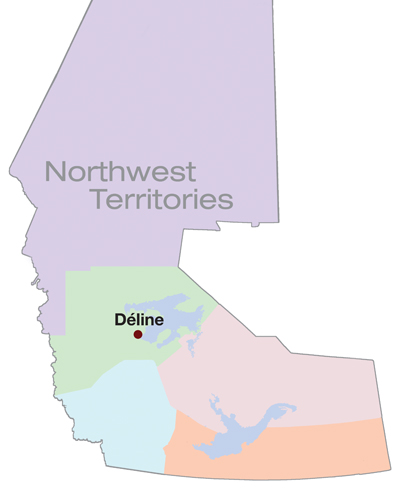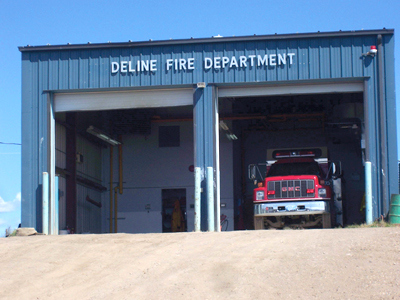
Features
Leadership
Leading by example
Fire is a living, breathing thing – something that grows, devours and eventually dies. A fire department isn’t much different. Whether career, composite or volunteer, a department navigates different growing phases, hiring cycles and changes.
December 5, 2011
By Kirk Hughes
Fire is a living, breathing thing – something that grows, devours and eventually dies. A fire department isn’t much different. Whether career, composite or volunteer, a department navigates different growing phases, hiring cycles and changes.
 |
|
| Proud members of the growing Déline Fire Department in the Northwest Territories. The department now boasts 25 volunteers. |
A little more than a year ago, the Déline Fire Department faced a major recruitment and retention challenge. Today, it is thriving. Here’s what happened.
 |
|
| Déline, located on the southwest arm of the Gret Bear Lake in the NWT.
|
Déline, located on the southwest arm of the Great Bear Lake in the Northwest Territories, has a charter community of about 600 people and is completely isolated, accessible only by airplane (except for about 60 days when the ice road can handle the weight of transport trucks). Fire fighting here is an extreme balance between doing the job and doing it safely. Communities like Déline (whose name means where waters flow) don’t have mutual aid – no other department is coming to help out in a major fire. It’s your crews versus the fire – winner takes all.
In the summer of 2010, the Déline Fire Department went through a remarkable transformation not typical of trends in fire departments across the country, particularly in the north: it started to grow. The process began with a conversation between the department and Christina Gaudet, the community’s senior administrative officer, who wanted to see an increase in firefighting effectiveness by the local department, which numbered six people at the time.
This was not an unreasonable request, but what followed was an important piece of the rebuilding puzzle – the authorization to spend money and recruit firefighters. The charter community of Déline added four firefighters immediately by allowing its employees to attend fires during business hours. This raised the number of firefighters to 10 within the first week of recruiting.
From there, veteran firefighters discussed who should be a firefighter and, once a name was selected, simply approached that person and asked if he or she were interested. If a recruit came on board, he or she filled out an application for approval by the fire chief. If the chief thought that person would help the department, the recruit was bunker-geared up and attended a training orientation. As word spread of the effectiveness of the recruiting process, more people started to ask if they could join. By the end of the first year, Déline Fire numbered 25 volunteers.
Recruiting people is one thing but keeping them is another. With firefighters secured, the goal moved toward retaining them, and what better way to do that than with some exclusive free items? Déline Fire made its first purchase, which consisted of t-shirts, sweaters, hats, shoulder flashes and helmet decals. Monetarily, this was a pretty meagre investment, but for morale it was priceless. Soon, Déline Fire sweaters and hats could be seen throughout the community being worn by members and officers alike. This presented the department with free advertisement and, ultimately, free recruiters.
 |
|
| Keeping volunteer firefighters engaged and motivated through training, special activities and fire-department wear has encouraged others to join.
|
With numbers and morale high, the task of training kicked into full gear. Unlike in the south, there are not a lot of fire colleges in the north, so the bulk of fire training is split between travelling fire marshals from the Northwest Territories and local trainers who have formal training and experience.
A training officer was selected and a course curriculum was created. From there, volunteers met twice a month for training, with one night dedicated to fire-ground operations and the other to administration and discussion, often over a free meal.
This led to a very fluent department: everyone felt comfortable sharing their input, ideas and suggestions with the fire chief and his officers. This method ensured that the most critical piece of the puzzle – department communications – was healthy. Firefighters were kept in the loop through posters, e-mails and meetings while the charter community and the local fire marshal’s office was kept up to date on activities through a detailed monthly report. Paperwork is never fun, but good reports had good effects, and Déline felt that right away when the fire marshal agreed to come to town and host a course.
Eventually, this communication method piqued the interest of St. John Ambulance in Yellowknife, which worked out a uniquely northern solution to the problem of medical response. Down south, paramedic crews respond to medical emergencies, but in small communities like Déline, medical response is often left to the local nursing station and the RCMP. St. John Ambulance saw this as a golden opportunity and authorized the training and equipping of the Déline Fire Department for medical response. Now, Déline Fire has medical equipment, advanced medical training and certified responders who can be called out to assist in any traumatic emergency.
All that said, no one joins the fire department to get free clothing, train all the time and have free meals. We join to fight fires, and the first test of the revitalized Déline Fire Department came just a few months into that transformation, on a frigid January afternoon when an alarm sounded at the local hockey arena.
Déline’s arena is more than a place to put on skates. It is a critical gathering place for youth, drum dances, weddings, fundraisers and other events. The facility links the entire community, so when word came that the arena was on fire, many fearfully gathered. In many communities, a fire in such a large building would mean disaster. Déline Fire Department responded with all resources, including Engine 1 and Tanker 2. Other privately owned water tankers arrived to help out. Firefighters were on scene in a matter of minutes and an aggressive interior attack was ordered by the first on-scene fire officer. Two firefighters entered the structure, with two in reserve and a safety officer monitoring the conditions. White smoke immediately bellowed out of the doorway of the kitchen. As more firefighters arrived, a second team was established to open the large Zamboni bay doors to allow the smoke to exit and clear the visibility for the search-and-rescue team to sweep the meeting hall.
Shuttling water trucks maintained critical water supply, providing interior firefighters with a constant stream to attack the fire. Within 10 minutes, reports emerged from interior units that the fire had been extinguished, the community hall had been searched for victims and the damage was contained to a small portion of the kitchen lobby. Grateful community members applauded the volunteer firefighters and thankful people still recall the heroic actions of the first two firefighters who went inside.
Since that day, Déline Fire has responded to several calls for service, from house fires to forest-fire evacuations, all of which have allowed the department to show its worth to the community.
Déline is a vibrant and strong place that deserved a ready and willing fire department. All communities deserve good fire protection, and despite all the hurdles, obstacles and growing pains, there is a feeling beyond words when you can report to a homeowner and fellow citizen that the fire is out and everyone is safe, and hear children say they want to be firefighters when they grow up. I guess our recruiters will be busy for years to come.
Kirk Hughes is the assistant fire chief and training officer for the Déline Fire Department in the Northwest Territories. Hughes is a graduate of the Dalhousie University Fire Service Leadership program. He has worked at Emergency Management Ontario and as a volunteer firefighter in Portage la Prairie, Man., Kilbride, Ont., and at Ball Industries. Prior to arriving in the Northwest Territories, he served as the RCMP emergency-services co-ordinator for the G8 Summit accommodations team. Contact him at khughes@firehousemail.com
Print this page